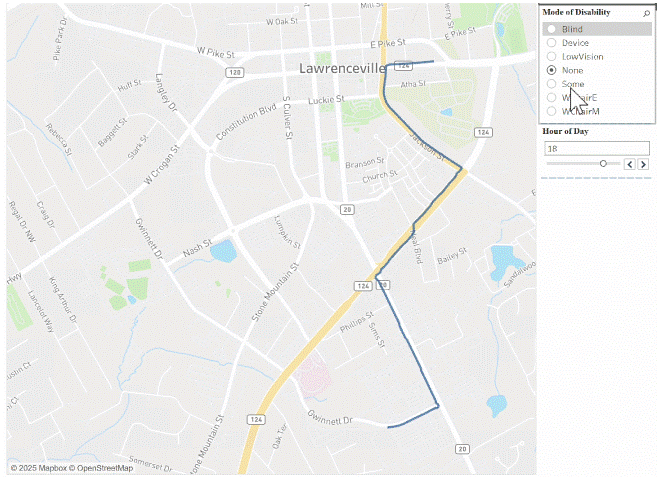Cyber-Physical Systems
Developing AI- and sensor-powered systems that respond to real-time thermal risks and enhance safe, personalized travel.
Background
Extreme temperature increasingly impacts transportation systems, yet current navigation tools, like Google Maps, do not account for weather or physical conditions of users. Our research addresses this critical gap by developing a cyber-physical infrastructure that enhances traveler safety and comfort through integration of environmental sensing and personal health data.
System Architecture
Our cyber-physical framework brings together AI, IoT, and mobility simulation through six key components:
- Conceptualization – framing human-infrastructure-health interdependencies
- Sensing – capturing real-time environmental and behavioral data
- Simulation – modeling cumulative exposure and system dynamics
- Mitigation – evaluating adaptation strategies
- Optimization – improving network design and intervention timing
- Navigation – supporting public health and planning decisions

Ongoing Work
We are currently building a comprehensive ontology that accounts for physical activity, personal vulnerability, and environmental conditions. This will enable simulation and navigation tools to reflect personalized health and comfort thresholds. Our future work focuses on enhancing decision-making capabilities with LLMs, offering responsive, inclusive guidance for multimodal travelers under extreme climate conditions.
Join Us
If you're a prospective student interested in pursuing research related to this topic, please visit this page for the latest updates on graduate opportunities. When completing your application, be sure to type "[Cyber-Physical Systems]" in response to the question: "If there are any special circumstances that you'd like me to know about, please list them here." (If there are actual circumstances to share, feel free to elaborate after the square brackets).
Related Publications
- Large Language Models for Traffic and Transportation Research: Methodologies, State of the Art, and Future Opportunities. https://doi.org/10.48550/arXiv.2503.21330
- Xu, G., Wang, X., Yao, R., Liao, Y., Sun, J., Cheng, X., ... & Barth, M. (2024, September). Improving Dynamic Wireless Charging System Performance For Electric Vehicles Through Variable Speed Limit Control Integration. In 2024 IEEE 27th International Conference on Intelligent Transportation Systems (ITSC) (pp. 3104–3110). IEEE. https://doi.org/10.1109/ITSC58415.2024.10919581
- Mo, P., Lyu, G., Fan, H., Liu, Z., Guin, A., & Guensler, R. (2024, September). Sidewalk ADA Design and Anomaly Condition Assessment Using GoPro Vibration Data. In 2024 IEEE 27th International Conference on Intelligent Transportation Systems (ITSC) (pp. 3751–3758). IEEE. https://doi.org/10.1109/ITSC58415.2024.10920184
- Liu, D., Fan, H., Guin, A., & Guensler, R. (2024). Evaluating Carpool Potential for Home-to-Work SOV Commuters Using a Scalable and Practical Simulation Framework. https://escholarship.org/uc/item/0gt458qt
- Liu, D., Fan, H., Guin, A., & Guensler, R. Carpoolsim: A Computational Framework to Assess Carpool Potential in Modeled Travel Demand Model. SSRN. https://ssrn.com/abstract=4844027 or http://dx.doi.org/10.2139/ssrn.4844027
